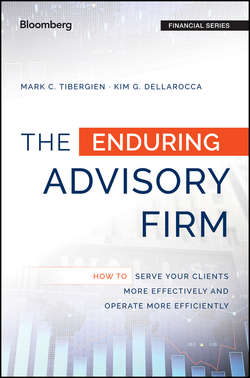Читать книгу The Enduring Advisory Firm - Mark C. Tibergien - Страница 9
На сайте Литреса книга снята с продажи.
Part I
The State of the Advisory Business
Chapter 1
Key Business Trends
What the Assumptions Mean for You
ОглавлениеOne thing is clear in any business: What got you here will not get you there. In our mind, this means that the assumptions about the advisory business over the past 100 years have changed dramatically.
Think of what has transpired since the 1970s alone.
In 1975, fixed commissions, which were the standard of practice for brokerage firms for decades, were eliminated. Discount brokers such as Schwab, Scottrade, and TD Ameritrade (Waterhouse) emerged as major players in the delivery of financial products. Many well-known brokerage firms subsequently went out of business.
This was one of the catalysts for the creation of the independent broker/dealer movement, in which registered reps were switched from being employees to becoming independent contractors. Their average payout went from 35 percent to 82 percent, which changed the economics of many broker/dealers.
Late in that decade and into the 1980s, the retail-oriented Registered Investment Advisor (RIA) emerged along with new support models, which we have come to know as “custodians.” These custodians, like Schwab, TD Ameritrade, Fidelity, and Pershing Advisor Solutions, replaced institutional brokers and providers by wrapping in technology, practice management support, and service teams as well as best execution capabilities. Today, the RIA segment represents almost $4 trillion9 in total assets, or roughly 20 percent of the U.S. retail market.
In the 1990s, no-load mutual fund platforms emerged, in which advisors could get access to packaged products for no commission payments. This reduced the cost of access. So, too, did the emergence of index funds provided by the likes of Vanguard and Dimensional Fund Advisors.
In the early part of this century, ETFs emerged as a threat to the mutual fund model because of its liquidity and low-cost appeal. Once again, traditional providers were undermined and the custodians saw their margins compressed as the revenue went from 12(b)1 fees provided by the mutual fund companies to their fund supermarkets to transactional revenue.
Конец ознакомительного фрагмента. Купить книгу
9
The Cerulli Report: “Advisor Metrics 2015. Anticipating the Advisor Landscape in 2020.”
